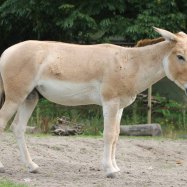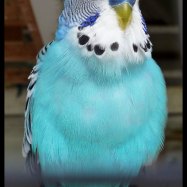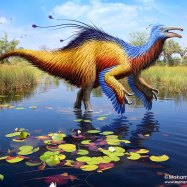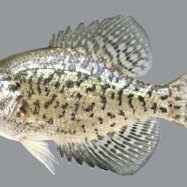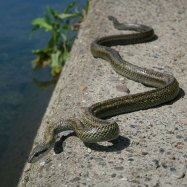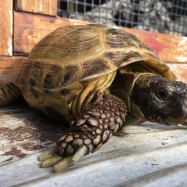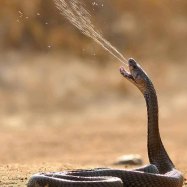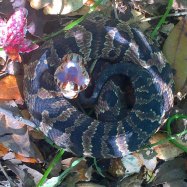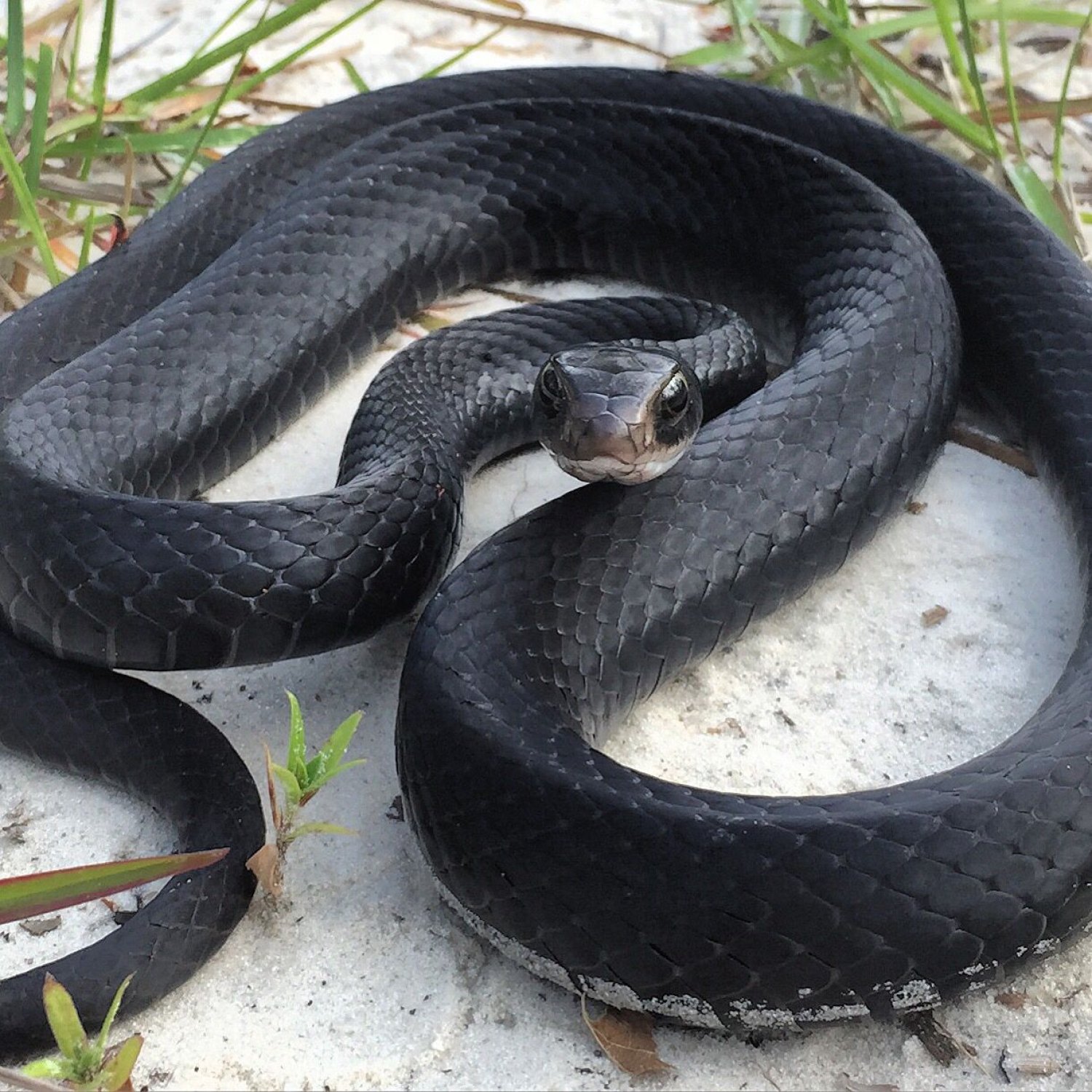
Southern Black Racer
3-5 feet
The Southern Black Racer is a common sight in the Southeastern United States. With a length of 3-5 feet, this non-venomous snake is a member of the Colubridae family. Known for their slender and elongated body shape, these racers are fast and agile, making them efficient predators. Keep an eye out for this sleek and swift reptile on your hikes and outdoor adventures. #SouthernBlackRacer #Colubridae #SnakesoftheSoutheast
Animal Details Summary:
Common Name: Southern Black Racer
Kingdom: Animalia
Habitat: Woodlands, forests, fields, and grasslands
The Magnificent Southern Black Racer: A Sleek and Elusive Reptile of the Southeastern United States
At first glance, you may mistake the Southern Black Racer for a common black snake. However, this reptile holds many remarkable qualities that set it apart from its counterparts. From its long and slender body to its swift movement, the Southern Black Racer is a fascinating creature that roams the woodlands, forests, fields, and grasslands of the southeastern United States and northeastern Mexico.The Southern Black Racer: A Closer Look
The Southern Black Racer, scientifically known as Coluber constrictor priapus, belongs to the kingdom Animalia, phylum Chordata, and class Reptilia Southern Black Racer. It falls under the order Squamata and family Colubridae, making it a close relative of other snake species such as rat snakes and king snakes.This sleek reptile can be found in a variety of habitats, particularly in the southeastern region of the United States. This includes states such as Texas, Louisiana, Mississippi, Alabama, Florida, Georgia, and the Carolinas. Additionally, they can also be found in northeastern Mexico.
A Thoroughly Carnivorous Diet
The Southern Black Racer is a carnivore, meaning it feeds on other animals to survive. Its diet mainly consists of smaller reptiles, amphibians, and even insects. As a highly adaptable species, the Southern Black Racer can thrive in different habitats and feed on a variety of prey. This makes it a vital player in maintaining a balanced ecosystem.A Habitat Fit for a Racer
As mentioned earlier, the Southern Black Racer can survive in a wide range of habitats Shiloh Shepherd. This includes woodlands, forests, fields, and grasslands. They thrive in these environments due to the abundance of sunlight and prey. Additionally, these areas provide shelter and hiding spots for the Southern Black Racer, making it easier for them to hunt and hide from predators.The Southern Black Racer's Appearance and Characteristics
One of the most distinctive features of the Southern Black Racer is its sleek and elongated body. They can grow up to 3-5 feet in length, making them one of the longer snake species in their range. This length allows them to move swiftly through their habitats, making them elusive and challenging to spot.As their name suggests, the Southern Black Racer is entirely black in color. However, some individuals may have small traces of white or gray on their belly. This coloring helps them to blend in their surroundings and avoid detection from predators.
The Southern Black Racer's Behavior
The Southern Black Racer is a diurnal species, which means it is most active during the day. They are excellent climbers and swimmers, making them versatile and skilled hunters. Their quick movements and agility allow them to swiftly move across various terrains, making them a formidable predator to smaller animals.Another interesting behavior of the Southern Black Racer is its hibernation pattern. During the colder months, they will hibernate in groups, known as "hibernacula," to conserve body heat and survive the winter.
The Threats Faced by the Southern Black Racer
Unfortunately, like many other animal species, the Southern Black Racer faces several threats that endanger its population. Habitat loss due to human development, roadkill, and accidental killings due to fear and misunderstanding are the primary threats to this reptile's survival.One of the main reasons for accidental killings is the resemblance of the Southern Black Racer to venomous snake species such as the cottonmouth and copperhead. However, unlike its venomous counterparts, the Southern Black Racer is entirely harmless and plays a crucial role in maintaining the ecosystem.
Conservation Efforts for the Southern Black Racer
Thankfully, various efforts have been put in place to protect and preserve the Southern Black Racer. The United States Fish and Wildlife Service has listed them as a species of "least concern" in their Endangered Species Act. This means that their population is currently stable, and they are not at risk of extinction.Additionally, conservation education programs have been implemented to raise awareness about the Southern Black Racer and its significance in maintaining a healthy ecosystem. These efforts have led to a better understanding and appreciation for this fascinating reptile, reducing the number of accidental killings.
Fun Facts about the Southern Black Racer
- The Southern Black Racer is one of the fastest snakes in North America, capable of reaching speeds of up to 8 mph.- Although they are expert climbers, they can't climb smooth surfaces like glass.
- They are renowned for their ability to "play dead" when threatened, staying motionless until the danger passes.
- The Southern Black Racer is entirely harmless to humans and other animals, making it a vital part of the food chain.
In Conclusion
The Southern Black Racer may seem like a simple black snake at first sight, but this reptile holds many impressive qualities. From its sleek and agile body to its important role in maintaining a balanced ecosystem, the Southern Black Racer is an essential species in the southeastern region of the United States.Efforts to conserve and protect this magnificent reptile have been successful, and it is currently considered a species of least concern. However, it is essential to continue educating and raising awareness about the Southern Black Racer to ensure its population remains stable and thriving in its natural habitats.

Southern Black Racer
Animal Details Southern Black Racer - Scientific Name: Coluber constrictor priapus
- Category: Animals S
- Scientific Name: Coluber constrictor priapus
- Common Name: Southern Black Racer
- Kingdom: Animalia
- Phylum: Chordata
- Class: Reptilia
- Order: Squamata
- Family: Colubridae
- Habitat: Woodlands, forests, fields, and grasslands
- Feeding Method: Carnivorous
- Geographical Distribution: Southern United States and northeastern Mexico
- Country of Origin: United States
- Location: Southeastern United States
- Animal Coloration: Black
- Body Shape: Slender and elongated
- Length: 3-5 feet
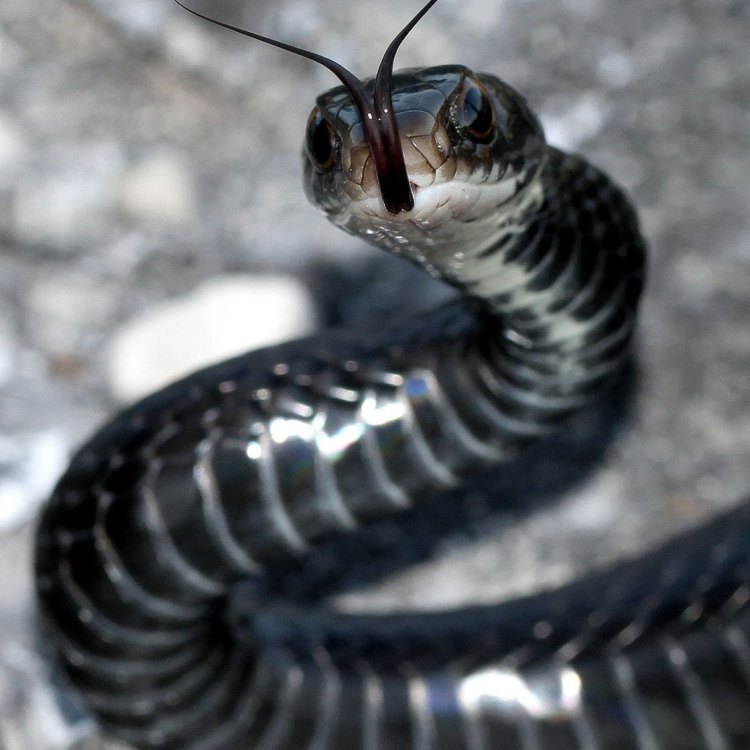
Southern Black Racer
- Adult Size: 3-6 feet
- Average Lifespan: 6-8 years
- Reproduction: Oviparous
- Reproductive Behavior: Mating occurs in the spring
- Sound or Call: Hissing sound
- Migration Pattern: Non-migratory
- Social Groups: Solitary
- Behavior: Fast and agile with excellent climbing skills
- Threats: Habitat loss and fragmentation, road mortality, and predation
- Conservation Status: Least Concern
- Impact on Ecosystem: Predator control of small mammal populations
- Human Use: Not commonly used by humans
- Distinctive Features: Sleek black body with a white chin and throat
- Interesting Facts: The Southern Black Racer is one of the most common and widespread snakes in the southeastern United States. It is known for its speed and agility, and can reach speeds of up to 6 miles per hour. Despite its name, the Southern Black Racer is not venomous and poses no threat to humans. It is often mistaken for the venomous Eastern Coral Snake due to its similar coloration, but can be distinguished by its longer body and distinct head shape.
- Predator: Birds of prey, larger snakes, and mammals
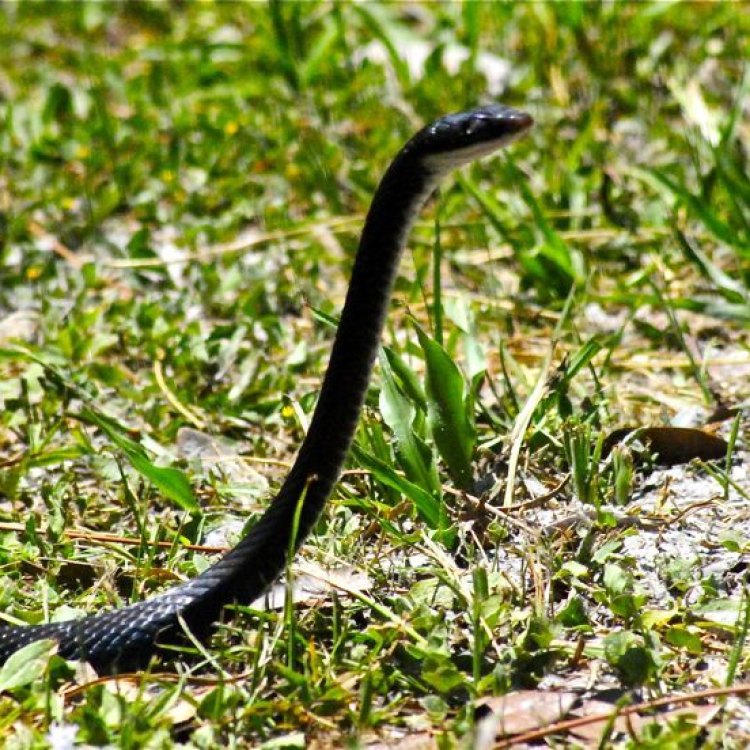
Coluber constrictor priapus
The Southern Black Racer: A Fast and Agile Snake of the Southeastern US
When you think of snakes, images of slithering and slow creatures may come to mind. However, in the southeastern United States, there is one species that defies this stereotype – the Southern Black Racer. This sleek and vibrant snake may not be as well-known as some other species, but it is a fascinating and important part of the region's ecosystem.The Southern Black Racer, also known as Coluber constrictor priapus, is a non-venomous snake that belongs to the Colubridae family PeaceOfAnimals.Com. It is a subspecies of the more widely known Northern Black Racer, and is found throughout the southeastern United States, from Florida to Maryland, and as far west as Texas. It is one of the most common and widespread snakes in the region, and can often be found in suburban and urban areas.
So what makes the Southern Black Racer so unique and interesting? Let's dive into its distinctive features, behavior, and role in its ecosystem.
Distinctive Features
The Southern Black Racer is a medium-sized snake, with adults ranging from 3 to 6 feet in length. It has a long, slender body, paired with a narrow, elongated head. Its body is smooth and glossy, with large scales that give it a sleek appearance. As its name suggests, it is mostly black in color, with a white chin and throat. However, some individuals may have varying shades of gray or brown, and may also have faint stripes or spots along their body.One of the key ways to identify a Southern Black Racer is by its distinct head shape Southern Hognose Snake. It has a slightly pointed snout and large eyes, giving it a more angular appearance compared to other snakes in the region. It also has round pupils, which is a characteristic of non-venomous snakes.
Interestingly, the Southern Black Racer's coloration and markings often lead to confusion and misidentification. It is often mistaken for the venomous Eastern Coral Snake, which also has a black, red, and yellow coloration. However, the Southern Black Racer's longer body, distinct head shape, and lack of a red snout can help differentiate it from the Eastern Coral Snake.
Behavior and Reproduction
The Southern Black Racer is a diurnal snake, meaning it is active during the day. It is a fast and agile species, capable of reaching speeds of up to 6 miles per hour. Its speed and agility make it an excellent climber, and it is often found in trees, shrubs, and other elevated areas.This snake is also known for its hissing sound, which it uses as a defense mechanism when threatened. It may also vibrate its tail and strike at potential predators, but it is non-venomous and poses no danger to humans.
In terms of reproduction, the Southern Black Racer is oviparous, meaning it lays eggs. Mating typically occurs in the spring, and females can lay up to 20 eggs in a clutch. The eggs are usually laid in a protected area, such as under logs or in leaf litter, and hatch after 2-3 months.
Threats and Conservation Status
The Southern Black Racer is listed as Least Concern by the International Union for Conservation of Nature (IUCN). This means that it is not facing any significant threats or population decline. However, like many other wildlife species, it does face some threats in its natural habitat.One of the main threats to the Southern Black Racer is habitat loss and fragmentation. With the increase in urbanization and development, its natural habitat is being destroyed and fragmented, making it difficult for the species to thrive. Another threat is road mortality, as these snakes are often found crossing roads and can be hit by vehicles.
Predation is also a threat to the Southern Black Racer, as it is a food source for birds of prey, larger snakes, and mammals. However, this species also plays an important role in its ecosystem by controlling small mammal populations, making it a vital link in the food chain.
Human Interaction
The Southern Black Racer is not commonly used by humans, but it does have some cultural significance in certain communities. In some parts of the southeastern US, this snake is believed to bring good luck and often featured in folk art and folklore.Additionally, the Southern Black Racer is a beneficial species to have in your yard or garden. It helps control rodent populations, making it a natural pest control option.
However, it is important for humans to respect and not disturb these snakes in their natural habitat. If you do come across one, it is best to observe from a safe distance and not attempt to handle or harm the snake.
Impact on Ecosystem
As mentioned earlier, the Southern Black Racer plays an important role in its ecosystem by controlling small mammal populations. This is crucial for maintaining a balanced ecosystem, as unchecked rodent populations can have negative effects on plant growth and other animal species. In this way, the Southern Black Racer serves as a natural predator control.In Conclusion
The Southern Black Racer may not be the most well-known snake in the southeastern US, but it certainly has its own unique features and importance in the region's ecosystem. With its sleek black body, distinctive head shape, and fast and agile behavior, it is truly a fascinating species to learn about and admire from a safe distance.Through conservation efforts and education, we can ensure that this iconic snake continues to thrive in its natural habitat and plays its important role in the delicate balance of the ecosystem. So the next time you come across a Southern Black Racer, remember to appreciate its unique beauty and importance in our natural world.
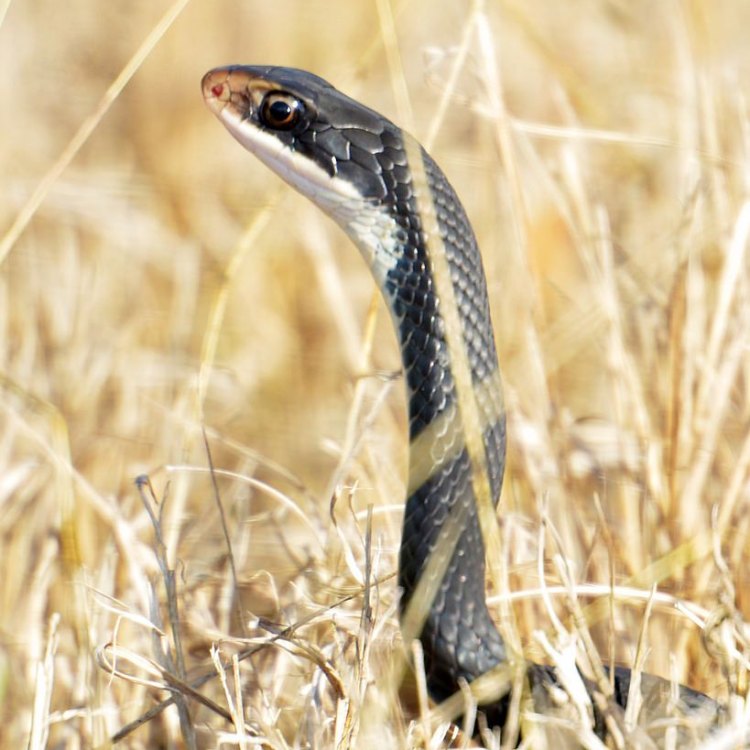
The Magnificent Southern Black Racer: A Sleek and Elusive Reptile of the Southeastern United States
Disclaimer: The content provided is for informational purposes only. We cannot guarantee the accuracy of the information on this page 100%. All information provided here may change without prior notice.


